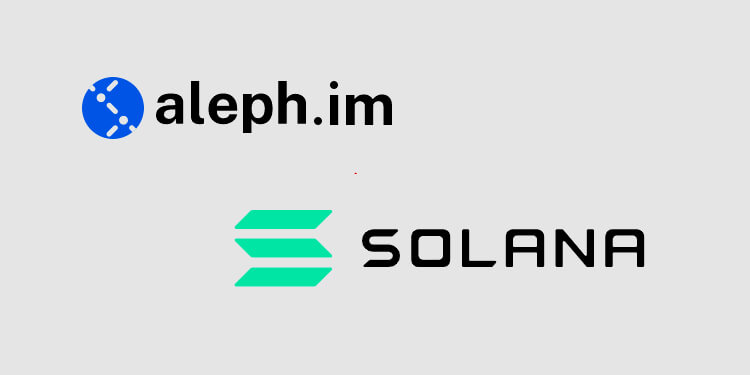Unveiling Aleph.im: A Deep Dive into the Decentralized Infrastructure Powerhouse
The cryptocurrency landscape is a vibrant tapestry woven with a multitude of projects, each aiming to solve specific problems and revolutionize different sectors. Among these, Aleph.im stands out as a unique player, offering a decentralized infrastructure solution specifically designed to empower decentralized applications (dApps).
This article delves into the intricate world of Aleph.im, exploring its core functionalities, underlying technology, and potential impact on the future of decentralized applications. We’ll unveil the magic behind Aleph.im and how it’s building the foundation for a truly decentralized future.
A Glimpse into the Decentralized Dream
Imagine a world where applications operate independently of centralized control, data is securely stored and accessible without relying on third-party servers, and users own and manage their digital identities. This is the essence of the blockchain revolution, and Aleph.im positions itself as a crucial piece of the puzzle.
By offering a decentralized infrastructure solution, Aleph.im aims to address the limitations of traditional, centralized app architectures. These limitations include:
- Single Point of Failure: Centralized servers pose a significant risk. If a central server goes down, the entire application can become inaccessible.
- Data Security Concerns: Centralized storage of user data makes it vulnerable to breaches and manipulation.
- Lack of User Control: Users often have limited control over their data and identities within centralized systems.
Aleph.im tackles these challenges by providing a decentralized network for storage, computing, and identity management. This network is built on a foundation of blockchain technology, ensuring security, transparency, and user control.
Unveiling the Architecture of Aleph.im
Aleph.im’s architecture is a complex yet elegant blend of on-chain and off-chain technologies. Here’s a breakdown of its key components:
-
Core Network: The heart of Aleph.im lies in its off-chain, peer-to-peer network. This network utilizes a technology called InterPlanetary File System (IPFS) for decentralized storage. IPFS distributes data across a network of nodes, eliminating the need for a central server and ensuring high availability and resilience.
-
Blockchain Integration: While the core network operates off-chain, Aleph.im seamlessly integrates with various blockchains like Ethereum, Polkadot, and Cosmos. This integration allows dApps built on these blockchains to leverage Aleph.im’s decentralized storage and computing capabilities. Blockchain technology is used for recording transactions, managing access control, and ensuring data integrity.
-
Channels: Aleph.im offers a unique feature called channels. These are essentially subnetworks within the main network, allowing for customized configurations and functionalities tailored to specific dApp requirements.
-
ALEPH Token: The native token of the Aleph.im ecosystem is ALEPH. This token serves several purposes, including:
- Network fees: Users pay ALEPH tokens for storage, compute resources, and other services offered by the network.
- Staking: ALEPH holders can stake their tokens to contribute to the security of the network and earn rewards.
- Governance: In the future, ALEPH token holders may have voting rights on network upgrades and proposals.
A Multitude of Offerings: What Does Aleph.im Provide?
Aleph.im goes beyond simply offering decentralized storage. It provides a comprehensive suite of functionalities designed to empower dApp development.
-
Decentralized Storage (dStorage): Aleph.im’s core offering is secure, censorship-resistant storage for dApps. This allows developers to store application data, user files, and other assets in a decentralized manner, eliminating reliance on centralized cloud storage providers.
-
Decentralized Computing (dCompute): Aleph.im provides serverless computing solutions for dApps. Developers can leverage the network’s computing power to run code and perform complex tasks without managing their own infrastructure.
-
Decentralized Identity (DID): Aleph.im facilitates the creation and management of self-sovereign identities (SSIs) on the blockchain. This allows users to control their digital identities and securely share data with dApps without relying on centralized identity providers.
-
Indexing Framework: Aleph.im offers a user-friendly indexing framework for developers to efficiently search and retrieve data stored on the network. This is crucial for building applications that require querying and analyzing blockchain data.
The Potential Impact of Aleph.im: A Decentralized Future for dApps
By offering a robust and secure decentralized infrastructure, Aleph.im has the potential to significantly impact the future of dApps. Here’s a closer look at some of the key benefits it brings to the table:
-
Enhanced Security and Censorship Resistance: By leveraging the power of blockchain technology and distributed storage, Aleph.im offers a more secure environment for dApps. Data is no longer stored in a single location, making it tamper-proof and resistant to censorship attempts.
-
Scalability and Cost-Effectiveness: Traditional centralized infrastructure can become a bottleneck for dApps as they grow in popularity. Aleph.im’s decentralized architecture allows for horizontal scaling, meaning the network can handle increased demand efficiently. Additionally, eliminating the need for centralized servers can potentially lead to cost savings for dApp developers.
-
Improved User Privacy and Control: Aleph.im’s decentralized identity solutions empower users to control their data and choose what they share with dApps. This fosters a more privacy-centric ecosystem where users are no longer beholden to centralized entities for managing their digital identities.
-
A Foundation for a Thriving dApp Ecosystem: By providing the necessary infrastructure blocks, Aleph.im can accelerate the development and adoption of dApps. This can lead to a more diverse and innovative decentralized app landscape, catering to a wider range of use cases.
Beyond the Core: Exploring Potential Use Cases of Aleph
The potential applications of Aleph.im’s technology extend far beyond simply powering dApps. Here are some exciting use cases that could be revolutionized by decentralized infrastructure:
-
Decentralized Cloud Storage: Aleph.im’s dStorage capabilities can be leveraged to create a secure and censorship-resistant alternative to traditional cloud storage providers. This can be particularly beneficial for storing sensitive data or information that needs to be immune to censorship.
-
Decentralized Web Hosting: Imagine websites hosted entirely on a decentralized network, eliminating the risk of downtime due to server issues or centralized control. Aleph.im’s infrastructure could pave the way for a more resilient and censorship-resistant web.
-
Data Marketplaces: Decentralized storage and identity solutions can facilitate the creation of secure data marketplaces. Users could control and monetize their data by securely sharing it with businesses or researchers in a transparent and permissioned manner.
-
Supply Chain Management: Decentralized storage and tamper-proof record-keeping offered by Aleph.im can revolutionize supply chain management. This can ensure the transparency and traceability of goods throughout the supply chain, reducing the risk of fraud and counterfeiting.
Challenges and Considerations: The Road Ahead for Aleph
While Aleph.im presents a compelling vision for a decentralized future, it’s important to acknowledge the challenges that lie ahead. Here are some key considerations:
-
Network Adoption: For Aleph.im to reach its full potential, widespread adoption by dApp developers and users is crucial. Increasing awareness and building a strong developer community will be essential.
-
Scalability and Performance: While Aleph.im offers scalability advantages over centralized solutions, ensuring efficient performance at a massive scale will require ongoing development and optimization of the network infrastructure.
-
Integration with Existing Systems: Bridging the gap between decentralized infrastructure and existing centralized applications will be necessary for wider adoption. Aleph.im needs to offer seamless integration tools for developers working in both realms.
The Future of Decentralized Infrastructure: A Collaborative Effort
The success of Aleph.im, and decentralized infrastructure solutions in general, hinges on collaboration within the blockchain ecosystem. Here’s what the future might hold:
-
Interoperability Between Networks: For a truly decentralized future, interoperability between different decentralized storage and compute networks is crucial. Collaboration between projects like Aleph.im, Filecoin, and Arweave can pave the way for a seamless and interconnected decentralized infrastructure landscape.
-
Standardization and Governance: As the decentralized infrastructure space matures, establishing common standards and robust governance models will be essential. This will ensure a secure, reliable, and user-friendly environment for dApp development and user adoption.
-
Integration with Decentralized Finance (DeFi): Decentralized storage and compute solutions like Aleph.im can play a crucial role in the growth of DeFi applications. Secure storage of financial data and efficient off-chain computation can unlock new possibilities for DeFi protocols.
Conclusion: Building the Blocks of a Decentralized Future
Aleph.im stands at the forefront of a revolution in infrastructure, offering a compelling vision for a decentralized future. By providing secure, scalable, and user-centric infrastructure solutions, Aleph.im empowers developers to build the next generation of dApps. While challenges remain, ongoing development, collaboration within the blockchain space, and a focus on user adoption are key to Aleph.im’s success in building the foundation for a truly decentralized future.






